
cessna 172 skyhawk maintenance manual
- The Cessna 172 Skyhawk Maintenance Manual is a comprehensive guide for ensuring the aircraft’s airworthiness and safety.
- It provides detailed procedures for routine inspections, repairs, and upgrades, covering both minor and major maintenance tasks.
- The manual emphasizes adherence to manufacturer specifications and regulatory requirements to guarantee optimal performance and longevity.
- Regular reference to this manual is essential for aircraft owners, mechanics, and pilots to maintain compliance with aviation standards.
1.1 Overview of the Cessna 172 Skyhawk
The Cessna 172 Skyhawk is a renowned single-engine, four-seat aircraft celebrated for its reliability and ease of handling.
Known as one of the most forgiving airplanes, it excels in training environments and is widely used for flight instruction and personal flying.
Its fuel efficiency and lower maintenance costs make it a cost-effective choice compared to similar models like the Cessna 182.
With updates over the years, such as the 1978 model featuring an upgraded gross weight and 180 hp engine, the Skyhawk remains a popular choice for pilots worldwide.
1.2 Importance of Regular Maintenance
Regular maintenance is crucial for ensuring the Cessna 172 Skyhawk’s airworthiness, safety, and optimal performance.
Proper upkeep prevents mechanical failures, reduces operating costs, and extends the aircraft’s lifespan.
Adhering to the maintenance manual’s guidelines ensures compliance with aviation regulations and maintains the aircraft’s value.
Neglecting routine checks can lead to critical issues, making consistent maintenance essential for safe and reliable flight operations.
1.3 Structure of the Maintenance Manual
The Cessna 172 Skyhawk maintenance manual is organized into clear, logical sections for easy reference.
-
provides an overview and essential safety guidelines.
- Pre-Maintenance Checks outline daily inspections and preparations.
- Airframe, Engine, and Avionics Maintenance detail specific tasks and schedules.
- Safety Procedures emphasize protocols for secure operations.
- Documentation covers record-keeping and compliance requirements.
Appendices offer additional resources, ensuring comprehensive coverage for all maintenance needs.
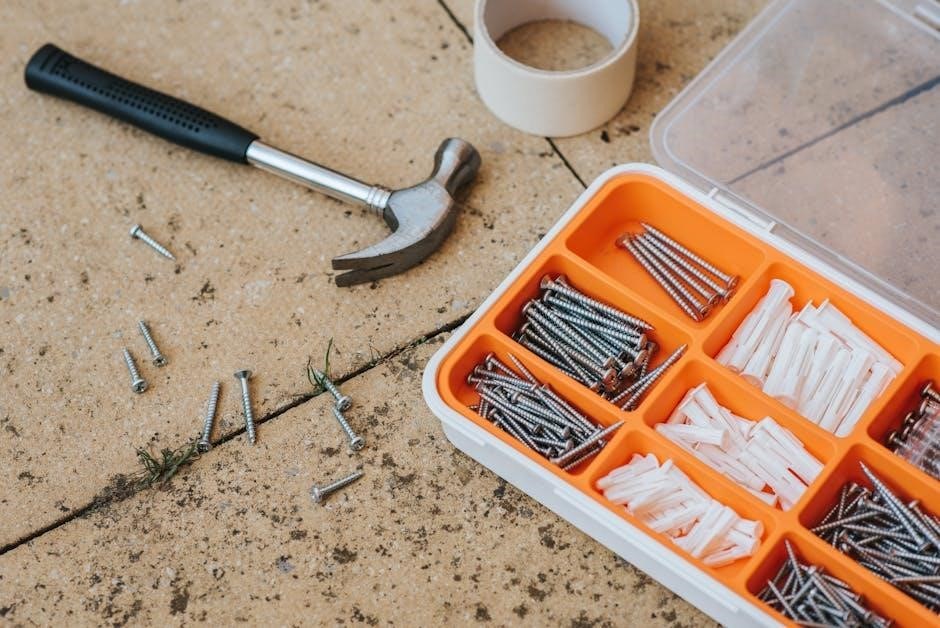
Pre-Maintenance Checks
Pre-maintenance checks ensure the aircraft is airworthy and safe for inspection. These include visual inspections, fluid level verification, and control surface functionality tests to identify potential issues early.
2.1 Daily Inspection Checklist
Daily inspections are critical for ensuring the Cessna 172 Skyhawk’s airworthiness. The checklist includes examining control surfaces for damage or wear, checking tire inflation and brakes, and verifying fluid levels. Inspect the propeller for nicks or cracks, ensure all lights function properly, and check for loose or missing fasteners. The aircraft’s instruments, including the altimeter, heading indicator, and airspeed indicator, must be verified for accuracy. Additionally, ensure the seatbelts and harnesses are secure, and all doors and windows are properly closed and latched. A thorough pre-flight inspection helps prevent in-flight issues and ensures safety.
2.2 Fuel and Oil Checks
Fuel and oil checks are essential for the Cessna 172 Skyhawk’s reliability and performance. Inspect the fuel for quality, color, and absence of contaminants or water. Ensure the oil level is within the recommended range and verify its viscosity for the operating conditions. Check the oil filter for cleanliness and proper installation. Draining a small sample of oil can help detect metal particles or debris. Additionally, inspect fuel lines, hoses, and connections for leaks or damage. Proper fuel and oil management prevents engine damage and ensures safe operation. Always use approved filters and follow manufacturer guidelines.
2;3 Control Surface Inspection
Inspecting control surfaces is critical for ensuring proper aircraft handling and safety. Check the ailerons, elevators, and rudder for any signs of damage, dents, or deformation. Verify that all surfaces move freely and are properly aligned. Inspect hinges and attachment points for security and wear. Ensure there are no obstructions or debris affecting movement. Test for play or looseness, which could indicate worn components. Address any irregularities immediately, as control surface issues can significantly impact flight performance and safety. Regular inspections help prevent potential failures during operation.

Airframe Maintenance
Regular airframe maintenance ensures the structural integrity of the Cessna 172 Skyhawk. Inspect for corrosion, dents, and rivet damage. Use approved materials for repairs to maintain safety and performance.
3.1 Exterior Inspection and Cleaning
Exterior inspection involves checking the airframe for damage, corrosion, or wear. Look for dents, scratches, or loose rivets on the wings, fuselage, and control surfaces. Clean the exterior regularly to remove dirt, bug splatters, and grease, which can degrade paint and aluminum surfaces. Use approved cleaning agents to avoid damaging materials. Pay special attention to areas around fuel caps, vents, and antennas. Regular cleaning enhances visibility and helps identify potential issues early. Always follow manufacturer guidelines for cleaning products and techniques.
3.2 Interior Maintenance and Upkeep
Interior maintenance ensures the cabin remains functional, safe, and comfortable. Regularly inspect seats, seatbelts, and carpets for wear or damage. Clean all surfaces with approved products to prevent dirt buildup and odors. Check instrumentation, controls, and electrical panels for proper function and cleanliness. Address any stains or spills promptly to avoid material degradation. Lubricate hinges and moving parts to maintain ease of operation. Ensure all safety equipment, such as fire extinguishers, is accessible and unobstructed. A well-maintained interior contributes to a safe and pleasant flying environment.
3.3 Landing Gear and Tire Maintenance
Regular maintenance of the landing gear and tires is critical for safety and longevity. Inspect the landing gear for wear, corrosion, or damage. Check tire pressure and inflate to the recommended levels. Look for signs of uneven wear or cracks in the tread. Lubricate moving parts, such as oleo struts, to ensure smooth operation. Inspect brake pads and rotors for wear and replace as needed. Ensure all bolts and nuts are tightened to specified torque values. Proper maintenance prevents failures during takeoff, landing, and taxiing.
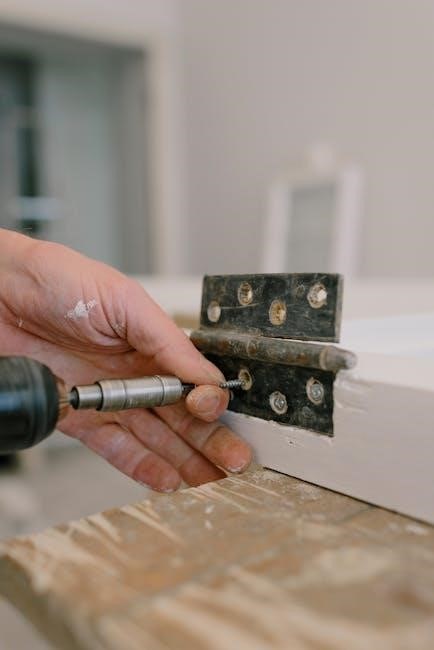
Engine Maintenance
Regular engine maintenance is essential for optimal performance and longevity. Tasks include oil and filter changes, spark plug inspections, and fuel system checks. Compliance with manufacturer guidelines ensures reliability and safety.
4.1 Oil and Filter Changes
Oil and filter changes are critical for engine health. The Cessna 172 Skyhawk requires oil changes every 50 hours of flight time. Use aviation-grade oil approved by the manufacturer. Drain the old oil carefully, inspect the filter for contaminants, and replace it with a new one. Properly dispose of used oil and filters. Follow the manual’s torque specifications for the oil filter. Regular changes prevent corrosion, lubricate moving parts, and ensure optimal engine performance. Always record the maintenance in the aircraft’s logbook for compliance and tracking.
4.2 Spark Plug Inspection and Replacement
Spark plug inspection and replacement are essential for engine efficiency. Inspect spark plugs every 100 hours or as indicated by performance issues. Remove plugs using a spark plug socket, checking for wear, fouling, or excessive gap. Clean or replace them if necessary. Ensure the gap meets specifications using a feeler gauge. Replace worn or damaged plugs with OEM-approved types. Tighten to the recommended torque to avoid damage. Proper maintenance ensures consistent ignition, prevents misfires, and maintains engine performance. Always log the replacement in the aircraft’s maintenance records for traceability and compliance.
4.3 Fuel System Cleaning and Inspection
Fuel system cleaning and inspection are critical for optimal performance. Inspect fuel lines, tanks, and connectors for leaks, corrosion, or blockages. Drain fuel samples to check for water, debris, or contamination. Clean or replace fuel filters as needed. Use a fuel strainer to remove impurities. Inspect fuel injectors or nozzles for proper spray pattern and flow. Clean or replace components as required. Ensure all connections are secure and tighten to specified torque. Document findings and maintenance actions in the aircraft’s service records for compliance and future reference.
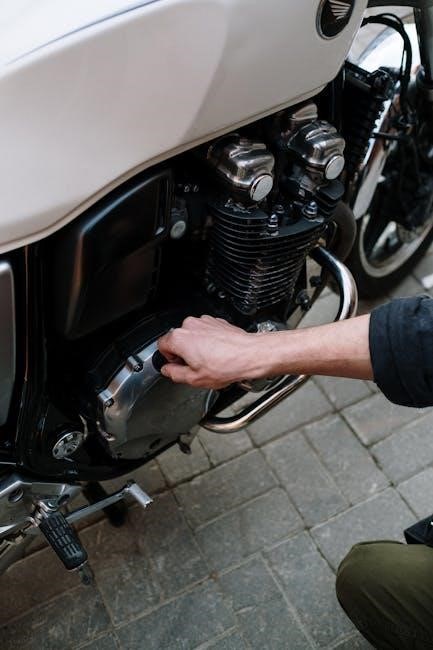
Avionics and Electrical Systems
Regular inspection of avionics and electrical systems ensures optimal functionality. Check navigation, communication, and electrical circuits for proper operation. Inspect wiring, connectors, and circuit breakers for wear or damage. Ensure all systems are functioning as designed to maintain safe and reliable aircraft performance during flight operations.
5.1 Navigation and Communication Equipment
Inspect the navigation and communication equipment regularly. Check the COM and NAV radios for proper functionality. Verify GPS accuracy and antenna connections. Test all switches and knobs for responsiveness. Ensure the intercom system is working correctly for clear communication between pilot and passengers. Inspect the VOR and GPS indicators for alignment and signal strength. Clean or replace any faulty components to maintain reliable navigation and communication during flights. Refer to the aircraft’s POH for specific testing procedures and ensure compliance with manufacturer guidelines.
5.2 Electrical System Troubleshooting
Identify and address electrical system issues promptly. Start by consulting the aircraft’s wiring diagram to locate potential faults. Check circuit breakers and fuses for tripped or blown components. Test battery voltage and charge rate to ensure proper power supply. Inspect wiring and connectors for damage or corrosion. Use a multimeter to verify continuity and resistance in critical circuits. Address any malfunctions by replacing faulty components or consulting authorized repair manuals. Always follow safety protocols when working with live electrical systems to avoid shocks or system damage.
5.3 Battery Maintenance and Replacement
Regular battery upkeep ensures reliable engine starts and system operation. Check the battery terminals for clean connections and secure them tightly. Monitor electrolyte levels and top up with distilled water as needed. Charge the battery using an approved charger, especially during extended storage. Inspect for signs of wear, such as cracks or corrosion. Replace the battery every 2-3 years or as recommended by the manufacturer. Always follow proper safety procedures when handling batteries to prevent acid spills and electrical hazards. Keep records of maintenance and replacements for compliance purposes.
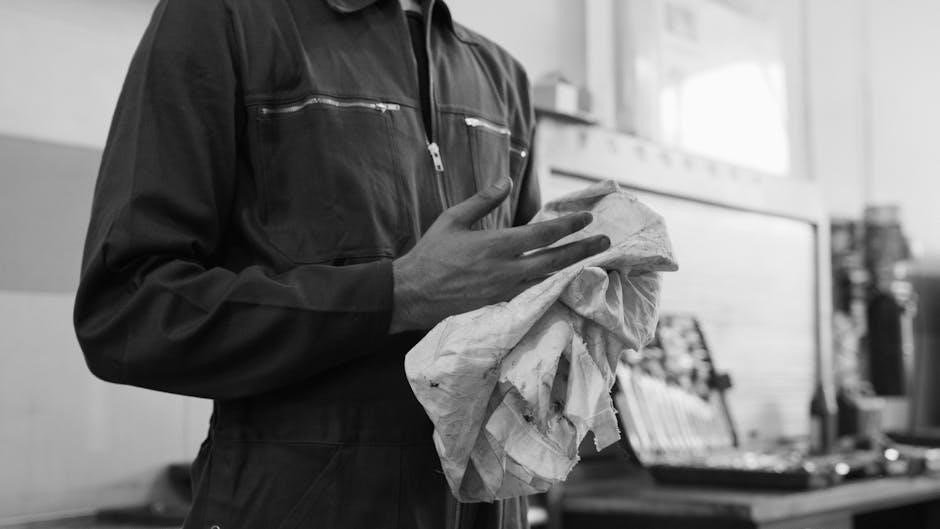
Safety Procedures
Always wear PPE, secure the aircraft, and use jack stands. Ensure proper ventilation and follow checklists. Maintain a clean workspace and be aware of electrical systems.
6.1 Personal Protective Equipment (PPE)
Wearing proper PPE is crucial for safety during Cessna 172 maintenance. This includes safety glasses, gloves, and a face mask when handling chemicals or debris. Steel-toe boots protect against heavy tools, while high-visibility vests enhance visibility. Hearing protection is essential in noisy environments. Ensure all PPE meets aviation standards to prevent injuries and maintain focus during procedures. Regularly inspect PPE for damage and replace as needed to guarantee effectiveness. Proper use of PPE is non-negotiable for personal safety and professional compliance.
6.2 Fire Safety and Emergency Protocols
Fire safety is critical during Cessna 172 maintenance. Keep fire extinguishers rated for aviation fuels nearby. Ensure emergency exits are unobstructed and clearly marked. Develop an evacuation plan, including steps for remaining calm, using extinguishers, and exiting quickly. Regular fire drills ensure preparedness. Always maintain a first-aid kit and know its location. Familiarize yourself with emergency contact numbers. Proper protocols prevent minor incidents from escalating, ensuring safety for personnel and the aircraft.
6.3 Tool Safety and Handling
Proper tool safety and handling are essential in Cessna 172 maintenance. Always use aviation-approved tools to avoid damaging components. Regularly inspect tools for wear or damage and replace them if necessary. Store tools in a clean, dry environment to prevent rust or deterioration. Use tools only for their intended purposes to maintain accuracy and safety. Follow manufacturer guidelines for tool usage and calibration. Proper tool handling reduces the risk of accidents and ensures precise maintenance outcomes. Reporting damaged tools promptly is crucial for workplace safety and efficiency.
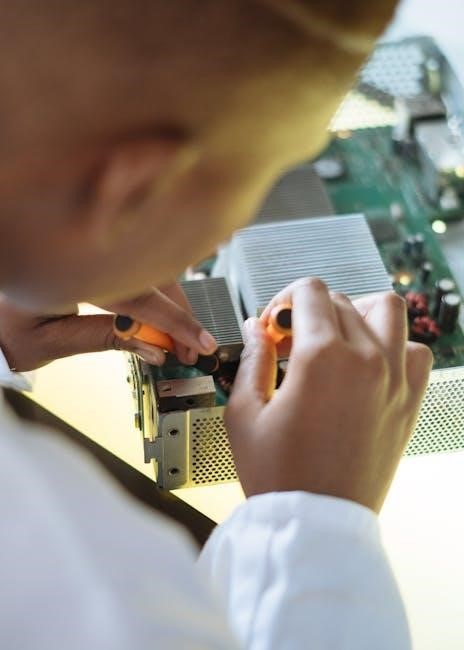
Tools and Equipment
Essential tools include wrenches, screwdrivers, and pliers. Specialized equipment like avionics testers and hydraulic system tools are required for specific tasks. Regular calibration ensures accuracy and safety.
7.1 Essential Tools for Maintenance
The Cessna 172 Skyhawk requires a set of essential tools for routine maintenance. These include wrenches, screwdrivers, pliers, and socket sets. A torque wrench is crucial for bolt tightening to specified values. Multimeters are needed for electrical system diagnostics. Tire pressure gauges and oil filter wrenches are also essential. Additionally, a set of precision tools like feeler gauges and rivet guns may be necessary for specific tasks. Always refer to the manual for tool specifications to ensure safety and compliance with maintenance standards.
7.2 Specialized Equipment for Specific Tasks
Specialized equipment is required for specific maintenance tasks on the Cessna 172 Skyhawk. A cowling wrench is essential for removing cowling fasteners without damage. A tire pressure gauge is necessary for accurate tire inflation checks. Landing gear servicing may require a jack and axle nut wrench. For avionics, a signal generator and circuit tester are needed for diagnostic work. Hydraulic testers are used for brake system maintenance. Always use tools designed for specific tasks to avoid damage and ensure safety during maintenance procedures.
7.3 Calibration and Maintenance of Tools
Regular calibration and maintenance of tools are crucial for ensuring accuracy and safety during Cessna 172 Skyhawk maintenance. Torque wrenches should be calibrated annually, while pressure gauges and multimeters require periodic testing. Tools should be stored in a clean, dry environment to prevent rust and damage. Routine inspections should identify worn or damaged tools, which must be repaired or replaced promptly. Follow manufacturer guidelines for calibration intervals and procedures to maintain tool reliability and compliance with maintenance standards.
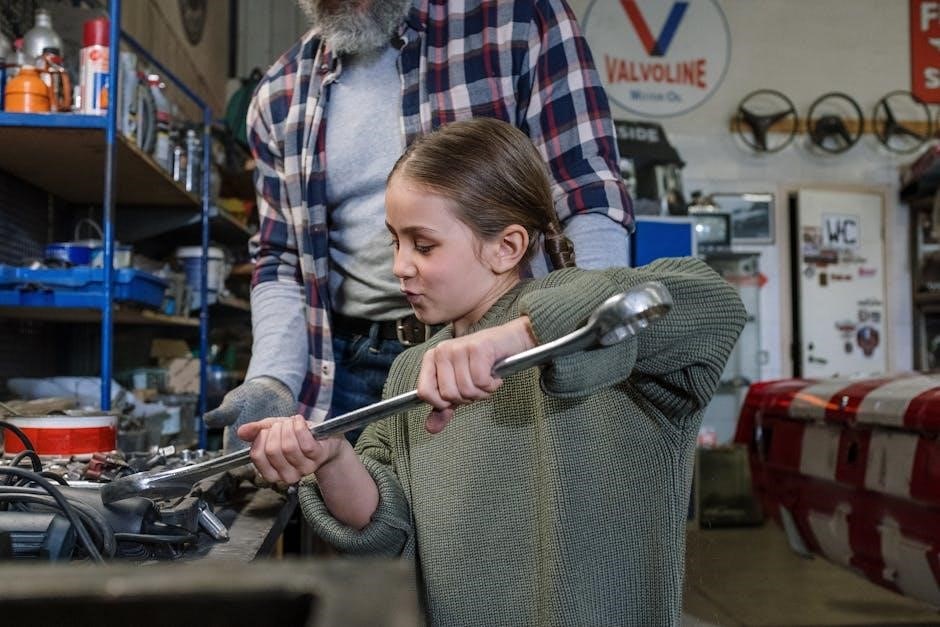
Documentation and Record-Keeping
Accurate documentation is critical for tracking maintenance activities, ensuring compliance, and providing a clear audit trail. Maintain detailed records of all inspections, repairs, and parts replacements.
8.1 Maintaining Service Records
Maintaining detailed service records is essential for tracking the Cessna 172 Skyhawk’s maintenance history. Records should include dates, descriptions of work performed, and the personnel or organizations involved. Ensure all entries are accurate and legible, adhering to aviation standards. Include details like part numbers, serial numbers, and compliance with specific regulations. Proper record-keeping ensures traceability, supports compliance audits, and provides a clear history for future maintenance decisions. Regularly review and update records to maintain their integrity and usefulness.
8.2 Logging Flight Hours and Maintenance Activities
Logging flight hours and maintenance activities is critical for tracking the Cessna 172 Skyhawk’s operational history. Record flight hours after each use to monitor usage patterns and schedule maintenance. Document all maintenance tasks, including inspections, repairs, and part replacements, with dates and details. This data helps plan future maintenance, ensures compliance with regulations, and provides a clear audit trail. Accurate and consistent logging improves safety, reduces downtime, and supports long-term aircraft reliability. Use standardized formats to maintain clarity and accessibility for review or audit purposes.
8.3 Compliance with Regulatory Requirements
Compliance with regulatory requirements is essential for the safe operation of the Cessna 172 Skyhawk. Adhere to FAA guidelines, including Part 91 for private aircraft and Part 135 for commercial operations. Regular inspections, airworthiness directives, and maintenance intervals must align with regulatory standards. Ensure all documentation meets FAA requirements for record-keeping. Non-compliance can lead to legal penalties, safety risks, or grounding of the aircraft. Stay updated on regulatory changes and consult official aviation authority resources for specific requirements applicable to your aircraft.
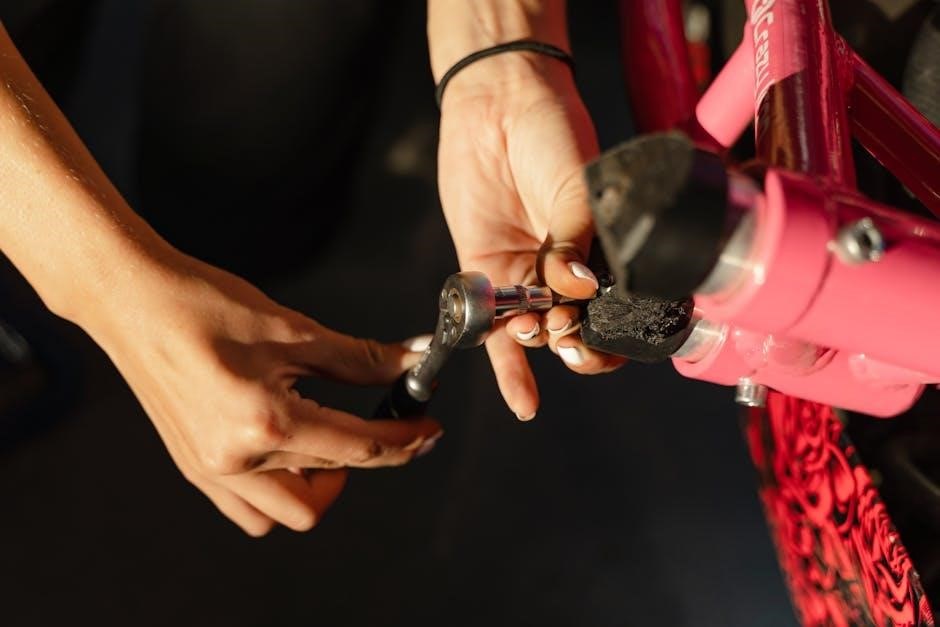
Troubleshooting Common Issues
Identify issues early to prevent escalation. Check sensors, wiring, and fluid levels. Follow manual procedures for systematic diagnosis. Use diagnostic tools to pinpoint faults efficiently.
9.1 Identifying and Addressing Leaks
Inspect fuel lines, hydraulics, and engine compartments regularly for signs of leaks. Use visual checks and tools like UV dye tests for fluid systems. Addressing leaks promptly prevents corrosion and system failures. Common causes include worn seals, loose connections, or damaged hoses. Tighten fittings and replace faulty components. Document all repairs and ensure compliance with safety standards. Always refer to the manual for specific procedures and torque specifications to maintain aircraft integrity and safety.
9.2 diagnosing Electrical System Failures
9.2 Diagnosing Electrical System Failures
Identify electrical system issues by checking circuit breakers, fuses, and wiring for damage or corrosion. Use a multimeter to test voltage and continuity in circuits. Common failures include faulty alternators, malfunctioning avionics, or loose connections. Refer to the manual for specific troubleshooting steps. Isolate the problem by testing individual components. Ensure all repairs meet FAA standards and consult a certified technician if uncertainty arises. Proper diagnosis ensures reliable electrical system performance and safety during flight operations.
9.3 Resolving Engine Performance Problems
Address engine performance issues by first identifying symptoms, such as rough running, low oil pressure, or high cylinder temperatures. Check air filters for blockages and spark plugs for fouling. Consult the POH for specific troubleshooting procedures. Verify fuel flow and mixture settings, and inspect for intake or exhaust leaks. Monitor engine instrumentation for abnormal readings. Perform compression tests if compression issues are suspected. Always follow the manual’s guidelines and seek assistance from a certified mechanic if problems persist. Timely resolution ensures optimal engine performance and safety.
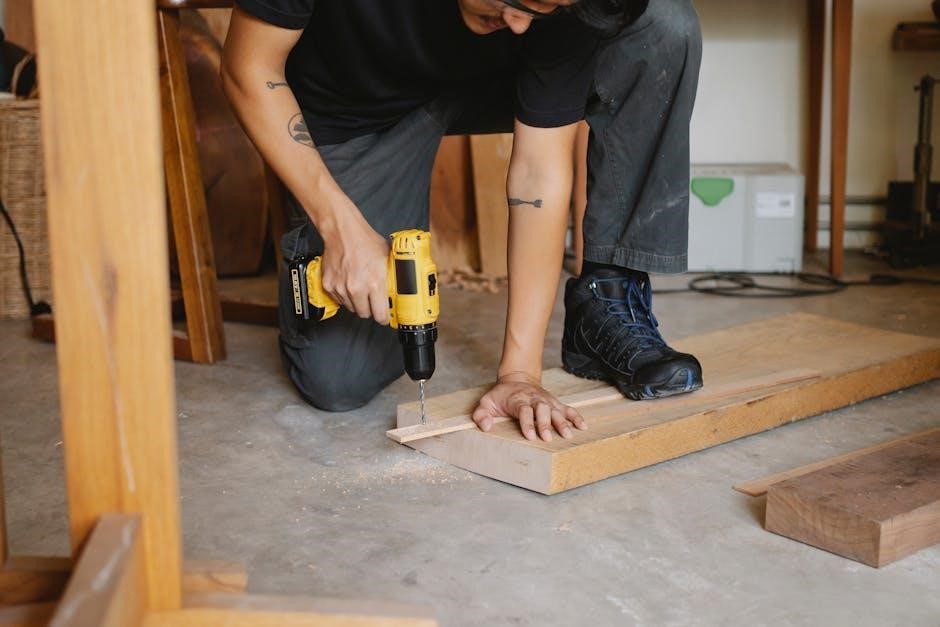
Environmental Considerations
Environmental considerations in Cessna 172 maintenance involve proper waste disposal of hazardous materials, use of eco-friendly cleaning products, and implementing sustainable practices to minimize environmental impact.
10.1 Waste Disposal and Recycling
Proper waste disposal and recycling are critical in Cessna 172 maintenance to minimize environmental impact. Hazardous materials like oil, chemicals, and batteries must be disposed of according to local and federal regulations. Recyclable materials, such as metals and plastics, should be separated and processed through approved facilities. Use designated containers for waste segregation to ensure compliance. Regular training for maintenance personnel on eco-friendly practices is essential. Always document waste disposal activities for accountability and regulatory reporting. Safe handling and storage of waste prevent contamination and environmental harm.
10.2 Using Eco-Friendly Cleaning Products
Using eco-friendly cleaning products is crucial for maintaining the Cessna 172 Skyhawk while minimizing environmental impact. These products are designed to effectively clean the airframe, windows, and interior without harmful chemicals. biodegradable detergents and water-based solvents are recommended for exterior surfaces to prevent corrosion and protect the environment. Interior cleaning should use non-toxic, low-VOC cleaners to ensure a safe cabin environment. Always check product compatibility with aircraft materials and follow manufacturer guidelines to avoid damage. Eco-friendly practices not only reduce environmental contamination but also promote sustainability in aviation maintenance.
10.3 Reducing Carbon Footprint in Maintenance
Minimizing environmental impact during Cessna 172 maintenance involves adopting eco-conscious practices. Using energy-efficient tools and solar-powered chargers reduces electricity consumption. Implementing waste reduction programs, such as recycling metals and fluids, lowers landfill contributions. Choosing sustainable materials for repairs and opting for digital documentation over paper-based records further lessens the carbon footprint. Additionally, promoting fuel-efficient practices during ground operations and maintenance flights helps reduce greenhouse gas emissions, aligning with global sustainability goals while ensuring the aircraft’s longevity and performance.
The Cessna 172 Skyhawk maintenance manual underscores the importance of regular, thorough upkeep. Adhering to these guidelines ensures safety, optimal performance, and regulatory compliance. Continuous learning and proactive maintenance are vital for preserving the aircraft’s condition and operational efficiency over time.
11.1 Summary of Key Maintenance Practices
Regular maintenance is crucial for the Cessna 172 Skyhawk’s performance and safety. Always adhere to the manual’s guidelines, ensuring inspections are thorough and timely. Key practices include routine checks of fuel, oil, and control surfaces, as well as proper cleaning and protection of the airframe. Engine maintenance, such as oil changes and spark plug inspections, must be done meticulously. Avionics and electrical systems require consistent monitoring, and tools should be calibrated to ensure accuracy. Documenting all activities is essential for compliance and tracking aircraft health. By following these practices, operators can ensure the aircraft remains airworthy and reliable.
11.2 Importance of Adhering to the Manual
Adhering to the Cessna 172 Skyhawk maintenance manual is critical for ensuring the aircraft’s airworthiness and safety. The manual provides detailed, manufacturer-approved procedures that are designed to prevent accidents and extend the aircraft’s lifespan. Deviating from these guidelines can lead to non-compliance with aviation regulations, potential system failures, and increased risk of accidents. By following the manual, maintenance professionals can identify and address issues early, reducing downtime and operational costs. Consistency in adherence also ensures that all maintenance activities are documented accurately, supporting long-term reliability and safety.
- Ensures compliance with aviation regulations.
- Prevents potential system failures.
- Supports accurate documentation.
11.3 Continuous Learning and Improvement
Continuous learning and improvement are crucial for maintaining the Cessna 172 Skyhawk at peak performance. Technicians should stay updated on new technologies, best practices, and regulatory changes. Attending workshops, seminars, and online courses can enhance skills and knowledge. Encouraging a culture of improvement ensures that maintenance processes evolve, reducing errors and improving safety. Sharing experiences with other professionals and reviewing updated manuals also contribute to ongoing development. This commitment to learning ensures the aircraft remains reliable, efficient, and safe for all operations.